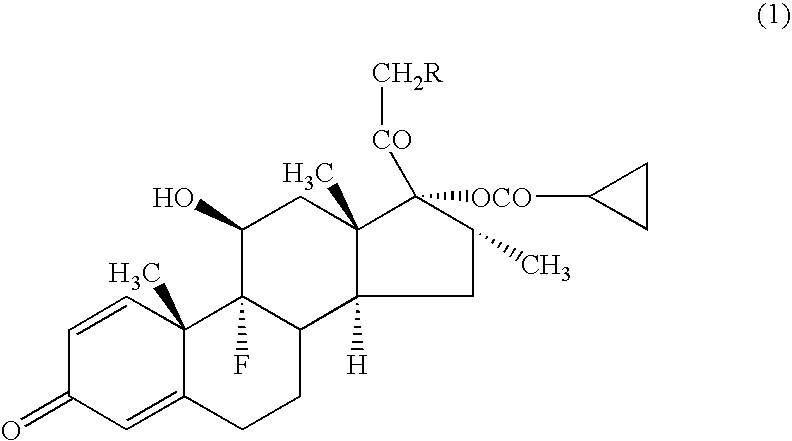Aqueous suspension for nasal drops
- Summary
- Abstract
- Description
- Claims
- Application Information
AI Technical Summary
Benefits of technology
Problems solved by technology
Method used
Image
Examples
example 1
[0043] A compound (1a) (in the formula (1), R=cyclohexylcarbonyloxy group) (average particle diameter 2.35 μm), crystalline cellulose-carmellose sodium (Avicel RC-A591NF, Asahi Kasei Co.), hydroxypropylcellulose (Nisso HPC M Type, Nippon Soda Co.), polyoxyethylene (20) sorbitan monooleate (TO-10MV, Nikko Chemicals Co.), propylene glycol, glycerol, sodium hydrogenphosphate, potassium dihydrogenphosphate, phenylethyl alcohol and 10% benzalkonium chloride solution were weighted according to amount of the prescription in Table 1, and added to the purified water 90 g and stirred for 30 minutes using homomixer (6000 rpm). To the obtained suspension was added the purified water to be total amount 100 g, and further stirred for 10 minutes to prepare the aqueous suspension for nasal drops as shown in examples 1-1 to 1-5, and comparative examples 1-1 to 1-2.
TABLE 1Amount of PrescriptionExampleComparative example(g)1-11-21-31-41-51-11-2Compound (1a)0.280.280.280.280.280.280.28Crystalline cel...
example 2
[0049] The aqueous suspension for nasal drops of examples 2-1 to 2-4 and comparative examples2-1 to 2-2 were prepared using the prescribed amount as shown in Table 3 by the same way as in example 1.
TABLE 3Amount of PrescriptionExampleComparative example(g)2-12-22-32-42-12-2Compound (1a)0.280.280.280.280.280.28Crystalline cellulose-1.51.51.51.51.51.5carmellose sodiumHydroxypropylcellulose10.50.10.0502(HPC-M)Polyxoyethylene (20)0.010.010.010.010.010.01sorbitan monooleateGlycerol2.52.52.52.52.52.5Propylene glycol0.50.50.50.50.50.5Sodium0.0350.0350.0350.0350.0350.035hydrogenphosphatePotassium0.0220.0220.0220.0220.0220.022dihydrogenphosphatePhenylethyl alcohol0.250.250.250.250.250.2510% benzalkonium0.050.050.050.050.050.05chloride solutionSterile purified waterq.s.q.s.q.s.q.s.q.s.q.s.Total100100100100100100
example 3
[0051] The aqueous suspension for nasal drops of examples 3-1 to 3-4 and comparative examples 3-1 to 3-2 were prepared using the prescribed amount as shown in Table 5 by the same way as in example 1.
TABLE 5Amount of PrescriptionExampleComparative example(g)3-13-23-33-43-13-2Compound (1a)0.280.280.280.280.280.28Crystalline cellulose-1.51.51.51.51.51.5carmellose sodiumHydroxypropylcellulose0.250.250.250.250.250.25(HPC-M)Polyxoyethylene (20)0.20.10.0050.00100.4sorbitan monooleateGlycerol2.52.52.52.52.52.5Propylene glycol0.50.50.50.50.50.5Sodium0.0350.0350.0350.0350.0350.035hydrogenphosphatePotassium0.0220.0220.0220.0220.0220.022dihydrogenphosphatePhenylethyl alcohol0.250.250.250.250.250.2510% benzalkonium0.050.050.050.050.050.05chloride solutionSterile purified waterq.s.q.s.q.s.q.s.q.s.q.s.Total100100100100100100
PUM
| Property | Measurement | Unit |
|---|---|---|
| Temperature | aaaaa | aaaaa |
| Fraction | aaaaa | aaaaa |
| Percent by mass | aaaaa | aaaaa |
Abstract
Description
Claims
Application Information
 Login to View More
Login to View More - R&D
- Intellectual Property
- Life Sciences
- Materials
- Tech Scout
- Unparalleled Data Quality
- Higher Quality Content
- 60% Fewer Hallucinations
Browse by: Latest US Patents, China's latest patents, Technical Efficacy Thesaurus, Application Domain, Technology Topic, Popular Technical Reports.
© 2025 PatSnap. All rights reserved.Legal|Privacy policy|Modern Slavery Act Transparency Statement|Sitemap|About US| Contact US: help@patsnap.com



